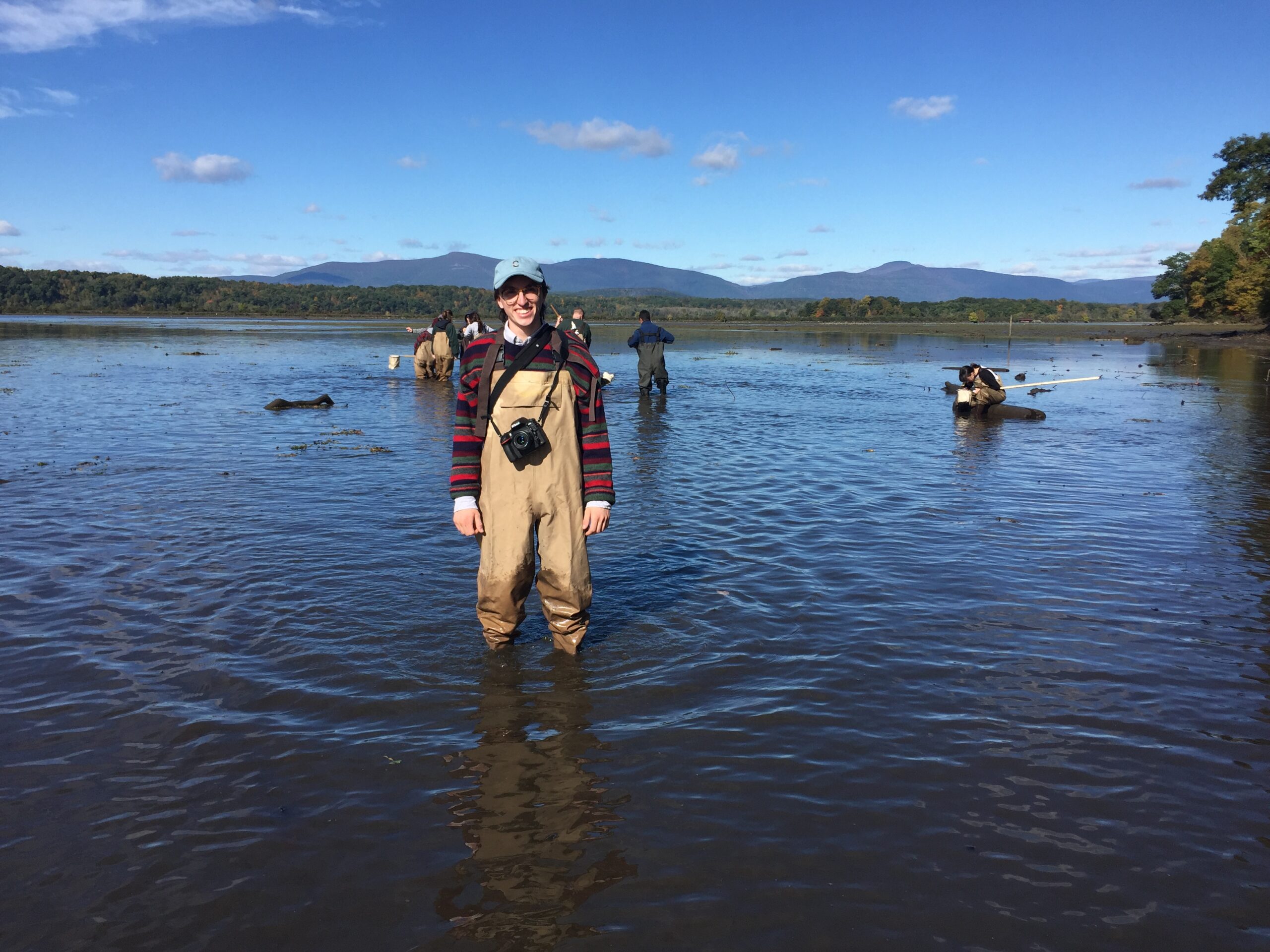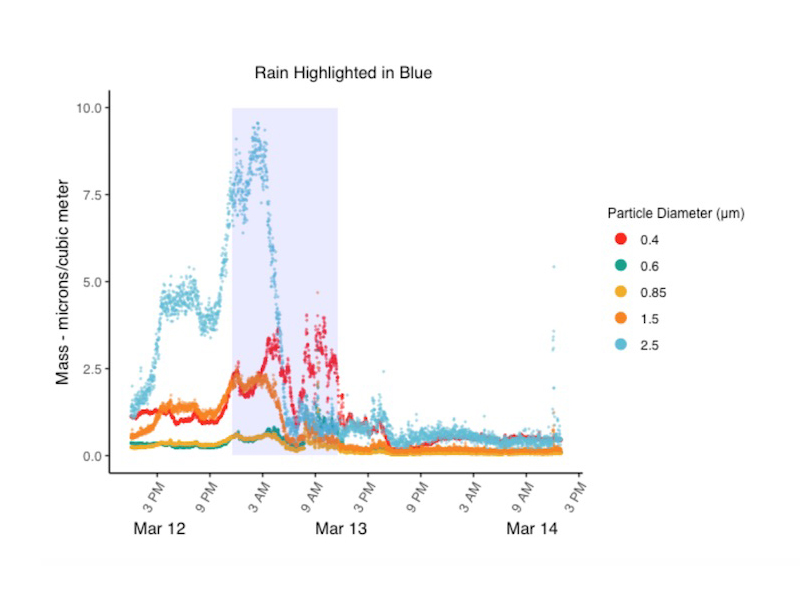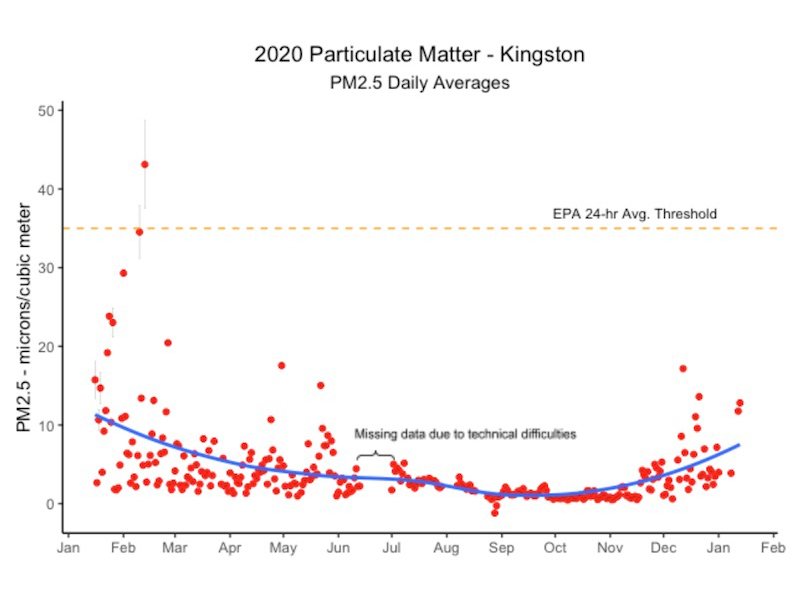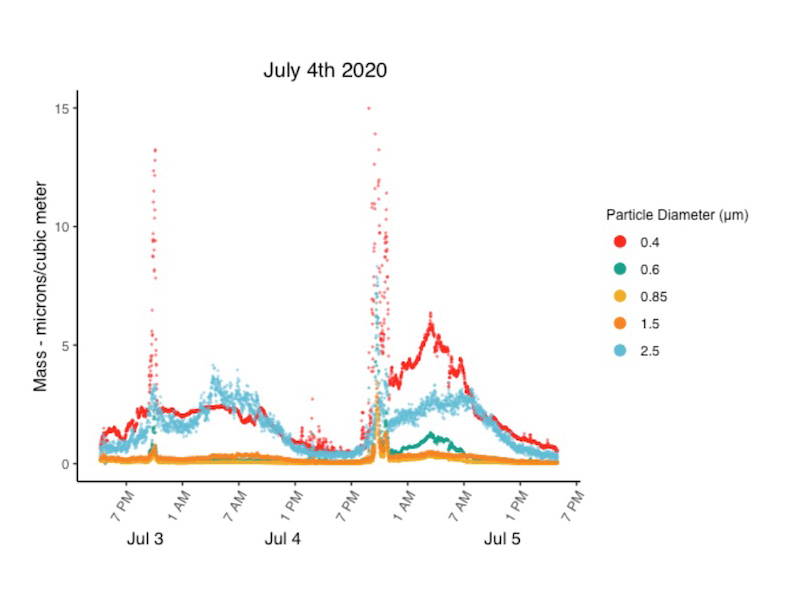Environmental Monitoring
A Community Resource
Community Science Lab
The Community Science Lab was created to support the work conducted by the Center for Environmental Sciences and Humanities. Built on the success of the Bard Water Lab and its partnership with the Saw Kill Watershed Community, CSL expands the Center’s reach by allowing us to refocus our work on projects that address the interconnectedness of land, air, water, and communities. The work of the Bard Water Lab and its goal of bringing water science to water communities continues through the Saw Kill Monitoring Program, as a CSL project.
Quality Assurance Project Plans
Saw Kill Watershed Community
Roe Jan Watershed Community
Water Quality Data
water quality analysis
Water Quality parameters
The Enterolert and Colilert assays are used to measure Enterococci, and Total Coliforms and Escherichia coli (E. coli), respectively.
Total coliforms include bacteria found in soil, surface waters, and human and animal waste. Fecal coliforms are a group of bacteria found in the digestive tracts of warm-blooded animals, including humans, and are excreted in feces. Within the fecal coliform group, E. coli is the best indicator of fecal pollution and the possible presence of pathogens. The Enterococcus group is also common in the intestinal tracts of warm-blooded animals, including humans, and is another important indicator of water contamination. Although many of these bacteria are not harmful and are part of a normal digestive system, fecal bacteria are correlated with swimming-associated gastrointestinal illness and are important to monitor in areas where people will be swimming or drinking the water.
Sources of fecal-indicating bacteria include wastewater treatment plant effluent, leaking septic systems, stormwater runoff, sewage from recreational boats, agricultural, domestic, or wild animal waste, improper land application of manure or sewage, and runoff from manure storage areas, pastures, rangelands, and feedlots. However, tracing the specific source of fecal bacteria contamination is complex. Information about the watershed, land uses, and pollution sources must be correlated with data on rainfall, stormwater management systems, and ecological systems. The potential human health risks vary depending on the source of bacteria and the type and number of associated pathogens.
The EPA recommends that Enterococci levels within surface waters used for recreational purposes, such as swimming, should not exceed 60 colony forming units (cfu) per 100mL of water.
Turbidity is a measure of particles suspended in water; it is measured in NTRs (nephelometric turbidity units) or JTRs (Jackson turbidity units).
The presence of minute particles in water diminishes its clarity. Turbidity increases from stormwater runoff in eroded areas, the removal of stream-bank vegetation, in-stream dredging and other disturbances, waste discharges, excess algae, decaying organic materials, and debris in streams. Suspended sediment particles create turbidity and provide surfaces for the attachment of disease-causing organisms and contaminants such as heavy metals (e.g. cadmium, zinc, mercury, lead, and chromium). These contaminants may accumulate in the food chain or concentrate on the bottom of the water body as particles settle.
Water that is highly turbid loses the capacity to support aquatic life. Elevated turbidity reduces the amount of light available for photosynthesis and decreases aquatic vegetation and food for invertebrates and fish. Furthermore, water temperature increases as suspended particles absorb heat from the sun, lowering dissolved oxygen levels. Fine particles cling to the gills of fish and filter-feeding organisms, reducing growth rates, increasing susceptibility to disease, and impairing egg and larvae development. On the stream bottom, settled particulates may smother newly hatched larvae or stream insects that in turn provide food for fish.
The degree to which turbidity affects aquatic systems and organisms depends on both the amount of sediment in the water and how long the turbidity lasts. For example, a study reported in the North American Journal of Fisheries Management indicates that fish start to show signs of stress at 10- to 100 NTUs. As NTUs increase to 10,000 and exposure increases from hours to days, fish abandon cover, show increased respiration, reduced feeding rates, and increased coughing. As exposures from 10- to 100,000 NTUs lengthen into weeks, fish show reduced growth rates, delayed hatching, and long- term reduced feeding success. Long term exposure to 500- to 100,000 NTUs can kill fish. Higher turbidity is also associated with higher levels of disease-causing microorganisms such as viruses, parasites, and bacteria.
Chlorophyll allows plants (including algae) to photosynthesize, that is, to use sunlight to convert simple molecules into organic compounds.
Chlorophyll a is the predominant type of chlorophyll found in green plants and algae. Chlorophyll a is a measure of the amount of algae growing in a water body. It can be used to classify the trophic condition of a water body. Although algae are a natural part of freshwater ecosystems, too much algae can cause aesthetic problems such as green scums and bad odors, and can result in decreased levels of dissolved oxygen. Some algae also produce toxins that can be of public health concern when they are found in high concentrations.
One of the symptoms of degraded water quality condition is the increase of algae biomass as measured by the concentration of chlorophyll a. Waters with high levels of nutrients from fertilizers, septic systems, sewage treatment plants and urban runoff may have high concentrations of chlorophyll a and excess amounts of algae.
Normal temperature ranges vary among lakes, streams, and rivers depending on geography and climate.
Water temperature also changes during daily and seasonal cycles, and weather events. The presence of bank vegetation, especially trees and shrubs that extend over the water, helps maintain a lower water temperature. Warmer water encourages algal blooms, changes metabolic rates in aquatic organisms, and affects water chemistry. In particular, dissolved oxygen decreases as water temperature increases. Changes in water temperature can also affect how chemical contaminants interact with and affect aquatic life.
Aquatic plants and animals have different tolerances for characteristics such as temperature, pH and dissolved oxygen. Aquatic organisms thrive at optimum temperatures according to species and can only survive at their “maximum” temperature for a few hours. At certain life cycle stages like spawning, fish have different temperature requirements. For example, the optimum temperature for spawning is 77 degrees Fahrenheit for the bluegill sunfish, and 48 degrees for the brook trout. The bluegill can tolerate a short-term maximum of 95 degrees, while the trout can tolerate a maximum of only 75.
Salt (sodium chloride) content in fresh water is assessed by measuring chlorides—soluble mineral compounds dissolved in water—in milligrams per liter (mg/L) of water.
However, salt content can also be measured through conductivity. Conductivity is the ability of water to conduct an electrical current through charged particles within the water. These particles include salts, minerals, chlorides, sulfides, and carbonate compounds. Values are reported in microsiemens per centimeter (uS/cm). “Specific conductance” measures conductivity at specific water temperatures. Changes in the water’s salt content (measured by chlorides or conductivity) can be an early indicator of changes in water quality. Polluted water usually has a higher specific conductance than unpolluted water. High specific conductance values often indicate pollution from road salt, septic systems, wastewater treatment plants, or urban/agricultural runoff. When streamflow is low, the concentration of salt is proportionately higher, with a corresponding increase in its potential to harm aquatic life.
A high concentration of salt renders water undrinkable, kills freshwater organisms, corrodes plumbing fixtures, and damages agricultural crops. Increased salinity affects the type of plants and aquatic organisms that can thrive in a particular lake or stream, becoming harmful to these organisms when salt levels exceed species’ tolerance range.
EPA has recommended that sodium levels in water not exceed 20 milligrams per liter (mg/L) for individuals on no-salt diets. The EPA Secondary Drinking Water Regulations recommend a maximum concentration of 250 mg/L for chloride ions (i.e. salts) in order to maintain a healthy ecosystem and safe drinking water.
Water Testing Protocols
Bard Water Lab Turbidimeter Protocol
- Shake your sample to be sure no settling has occurred. Fill a clean sample cell to the line (~15mL) with sample and cap it, taking care to handle it by the top only (smudges on the glass will change readings).
- Use a lint-free cloth to wipe down the cell and remove any water spots and fingerprints.
- Apply a thin film of silicone oil – one or two drops should do. Wipe with a soft cloth until there’s an even film over the entire cell’s surface.
- Turn the turbidimeter on and press the RANGE key until the display says “AUTO RNG.”
- Insert the cell into the turbidimeter compartment so that the triangular orientation mark aligns with the raised mark in front of the compartment.
- Close the compartment, press READ and record the turbidity in NTU.
- If sample is highly turbid, you may need to perform a dilution and re-read the turbidity. First try a 1:10 dilution (2 ml sample + 18 ml DI water).
- Empty the cell of sample, carefully rinse the cell out and return to step 1 for the next sample.
Quality Control Notes
- Blank: run one blank sample (using autoclaved DI water as “sample”) during each sampling run. Record the turbidity reading.
- Positive control: run a duplicate sample for Site #2 during each sampling run. Record the turbidity reading.
Preparing Sample
- Carefully crack open the Colilert media and empty into a sterile 120mL vessel (with sodium thiosulfate powder).
- Gently shake the water sample you’ve collected and using a sterile pipette, place 10 ml of sample in the vessel, followed by 90 ml of autoclaved DI water (for a 1:10 dilution).
- Close the vessel and invert gently until media is fully dissolved.
- Carefully open a Quanti-Tray by pulling the tab gently outwards and gripping around the plastic side of the tray with one hand, pressing slightly to open it wider.
- Pour the entire contents of the vessel into the tray. Pour slowly to avoid creating bubbles.
- Gently tap out big bubbles before sealing.
- Taking care not to spill contents, place the tray in the sealer mold (face down) and gently push into sealer (open end is up, last to go in). The sealer will “grab” the tray and roll it through at the proper speed. Push only enough to engage the tray.
- Place a sticker label on the back of the tray and fill in the sample information.
- Place tray in incubator set at 35 degrees Celsius.
Evaluating MPN
- After the incubation period (24 hours), remove the tray from the incubator.
- To measure total coliforms, count the number of yellow wells (as yellow or more yellow than the comparator), record number big and number small wells.
- To measure E. coli, place the tray under the UV light box and count the number of large and small wells with a bright, blue fluorescence that are also yellow. Mark fluorescing wells with sharpie; this is a good idea in case you need to recount or get interrupted.
- Use the MPN (most probable number) chart provided to determine the amount of enterococcus per 100mL sample. If the sample is diluted, you must multiple by the dilution factor (multiple by 10 for a 1:10 dilution).
- Record data (number of positive wells is important information to gather) on the lab computer in the Water Lab Data spreadsheet under the “Colilert” tab.
Quality Control Notes
- Blank: run one blank sample (using autoclaved DI water as “sample”) during each sampling run.
- Positive control: run a duplicate sample for Site #2 during each sampling run.
Download PDF
Preparing Sample
- Carefully crack open the Enterolert media and empty into a sterile 120mL vessel (with sodium thiosulfate powder).
- Gently shake the water sample you’ve collected and using a sterile pipette, place 100 ml of sample in the vessel.
- Close the vessel and invert gently until media is fully dissolved.
- Carefully open a Quanti-Tray by pulling the tab gently outwards and gripping around the plastic side of the tray with one hand, pressing slightly to open it wider.
- Pour the entire contents of the vessel into the tray. Pour slowly to avoid creating bubbles.
- Gently tap out big bubbles before sealing.
- Taking care not to spill contents, place the tray in the sealer mold (face down) and gently push into sealer (open end is up, last to go in). The sealer will “grab” the tray and roll it through at the proper speed. Push only enough to engage the tray.
- Place a sticker label on the back of the tray and fill in the sample information.
- Place tray in incubator set at 41 degrees Celsius.
Evaluating MPN
- After the incubation period (24 hours), remove the tray from the incubator.
- To measure enterococcus, place the tray under the UV light box and count the number of large and small wells with a bright, blue fluorescence. Mark fluorescing wells with sharpie; this is a good idea in case you need to recount or get interrupted.
- Use the MPN (most probable number) chart provided to determine the amount of enterococcus per 100mL sample. If the sample is diluted, you must multiple by the dilution factor (multiple by 10 for a 1:10 dilution).
- Record data (number of positive wells is important information to gather) on the lab computer in the Water Lab Data spreadsheet under the ‘Enterolert’ tab.
Quality Control Notes
- Blank: run one blank sample (using autoclaved DI water as “sample”) during each sampling run.
- Positive control: run a duplicate sample for Site #2 during each sampling run.
Download PDF
Bard Water Lab Fluorometer Protocol
- Select the correct Aquafluor fluorometer to measure your parameter; each fluorometer is only set up to measure 2 of 4 parameters. One Aquafluor measures Phycocyanin (channel A) and CDOM (channel B), while the other measures optical brighteners (channel A) and Chlorophyll (channel B). Check this by turning on the device and pressing the button, which will show you the parameters it measures.
- Turn on the fluorometers by pressing the button, and wait at least 5 seconds for the instruments to boot up.
- Using gloves, obtain a plastic cuvette (NO GLASS CUVETTES), making sure that the outer surfaces are clean and free of noticeable scratches or marks. Check for the sharpie mark on the rim of the cuvette; make sure to insert the cuvette with this side facing you for every reading.
- Run one blank sample FIRST (using autoclaved DI water) for all 4 channels before measuring the other samples. Follow the instructions below and repeat steps 5–14 for each sample.
- Rinse the cuvette with DI water 3 times.
- Gently agitate your water sample to resuspend any particles that have settled to the bottom.
- Rinse the cuvette with your sample 3 times, then fill the cuvette until it is ¾ full (do not fill the cuvette to its maximum volume).
- Gently clean off any smudges or liquid droplets from the outside of the cuvette with a KIMTECH wipe.
- After opening the small hatch to the sample bay, place your sample into the fluorometer, making sure not to spill any of the contents of the sample into the interior of the device. If a spill occurs, quickly invert the device and immediately let a member of the BWL know.
- Select your desired parameter to measure using the button.
- Press either of the two buttons, and record the measured parameter in RFU. Make sure measure all 4 parameters (Chla, PC, OB, and CDOM) for each sample.
- Empty the cuvette and start at step 5 to measure the next sample.
- Finally, read one more blank sample after all of the other samples have been measured.
Important Notes
- Positive control: Measure the Site 2 sample twice (denoted on the data sheet as 2A and 2B) for each parameter to provide an indication of instrument variation.
- If your cuvette becomes too dirty or scratched, you may discard it and take a new one. However, you MUST run another blank for all 4 parameters before proceeding to the next sample. This allows us to account for variability between cuvettes.
Get involved at CSL
Become a Volunteer

We believe that all communities should have access to drinkable water, breathable air, and fertile soil. Our research engages communities in collaborative environmental monitoring and scientific studies, in support of environmental justice. We work to make local monitoring data accessible, providing science as a resource to meet community needs. Climate change will amplify these needs. In response, we study land, air, and water to explore how crucial data can be used to help build community resilience and adaptation.
Our Tools
The Community Science Lab has the ability to measure a wide range of parameters, conditions, and contaminants in water, air, and soil. We are building additional capacity, through the monitoring equipment and instrumentation of our core lab facility, in order to provide environmental testing in support of community concerns, particularly as related to public health and climate change. Our initial efforts are focused on addressing the impacts of climate change on carbon storage, nutrient-mediating microbes, and waterborne pathogens that cause human disease. The data we generate will help to address pressing issues including: harmful algal blooms in drinking water reservoirs, raw sewage in public waterways, and the degradation of aquatic ecosystems globally.
Our Approach
Community science involves scientists and communities doing science collaboratively to address local priorities, in a way that leads to change. This process has the potential to address inequity by building community capacity while focusing on problems of global importance. Community or local expertise is considered equally (if not more) important to scientific expertise in the practice of community science.
Become a Community Science Lab Intern

This internship is ideal for students interested in engaging with both the Bard and outside community. At the lab, you’ll support our monitoring programs, attend community meetings, and take part in community outreach. As an intern, you’ll work closely with community members and Bard faculty, staff, and students. Interpersonal skills and an interest in bettering communication skills are a must.
As a Community Science Lab Intern, you’ll have certain jobs that are required, mostly on a monthly basis. These include assisting with the monthly monitoring program, prepping for community meetings, and updating the website.
SPECIFIC TASKS
- Organize and participate in community environmental monitoring programs and be comfortable taking a leadership role.
- Collaborate with other students and community members on projects and presentations.
- Assist in general lab tasks and analyses.
- Fulfill additional administrative duties as needed, such as social media support, website updates, newsletter articles, and data entry and management.
- Evening and weekend hours are required.
PREFERRED SKILLS
- Bard Driver
- Detail oriented
- Comfortable working in the laboratory and in the field (i.e., outdoors)
Bringing Water Science to Water Communities
What do we need right now to advance water stewardship in the Hudson Valley? More water sampling? More community involvement? More laws? Science can be used as a tool to address many of these important questions, and help map a way forward in these complicated times. M. Elias Dueker, the Center’s director, presents a framework for community-centered science in this webinar hosted by the Hudson River Watershed Alliance.
webinar
presentation
FIREWORKS
Human activity highly affects presence and circulation of particulates. Activities such as burning wood, oil, or gas, vehicular idling, and construction all contribute to the circulation of particulates in the air.
PDFPARTICULATE MATTER
There are limited data available regarding ambient particulate matter concentrations in the city of Kingston. As a result, it is difficult to collate these data with other regional data streams.
Button TextTEMPERATURE INVERSION
While some natural phenomena such as heavy rainfall can decrease our exposure to air pollution, others can increase it. One of these phenomena is a temperature inversion.
Button TextRAIN
Meteorological patterns are incredibly important when monitoring particulates, with temperature, relative humidity, wind speed, wind direction, and rainfall among the most important parameters. Rainfall, for example, is known to reduce the presence of airborne particulates through a process known as washing.
Button Text



